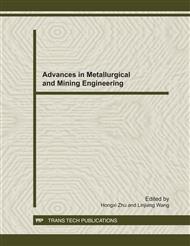p.666
p.671
p.675
p.680
p.687
p.693
p.698
p.702
p.709
Enhance the Process of Sedimentation for Copper Concentrate Pulp Using Combined Reagent
Abstract:
Due to the existing fine copper concentrate particles in the thickener overflow which can’t be reused, the water and copper resources have been wasted for a long time. In this study, the combination of coagulant (PAC and PAFC) with flocculant (N83376) were used to enhance the process of sedimentation of copper concentrate pulp, and the results of the above were compared with those when coagulant and flocculant was used alone. It is suggested that PAC and PAFC were both effective with the combination of N83376, however, excess of PAFC resulted in dispersion of particles. Therefore it was feasible to select PAC and N83376 as final combined reagent. The effectiveness of the coagulant and flocculant were evaluated based on the turbidity and the removal rate of suspended solids (SS) of the supernatant. It can achieve 17.03NTU of turbidity and 94.82% of SS removal rate with 750g/t PAC and 1.25g/t N83376, at pH 9~11. The results of filtration test indicate that the performance of copper concentrate pulp after coagulation-flocculation was improved. The filter rate was 0.45 ml/s faster than without reagent, and the water content of filter cake also decreased 1.84%.
Info:
Periodical:
Pages:
687-692
Citation:
Online since:
November 2011
Authors:
Keywords:
Price:
Сopyright:
© 2012 Trans Tech Publications Ltd. All Rights Reserved
Share:
Citation:


